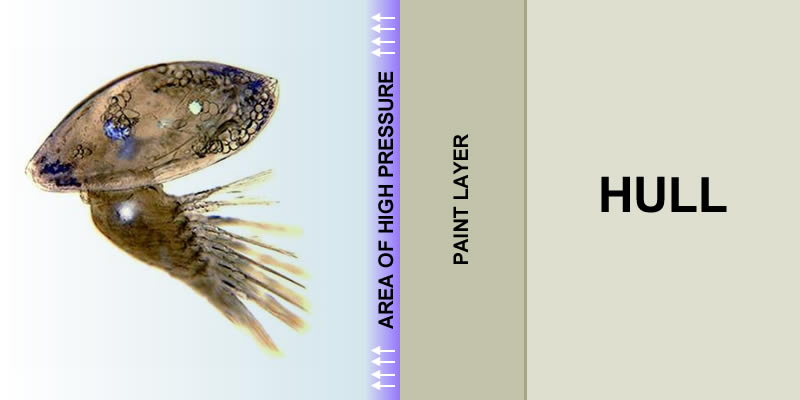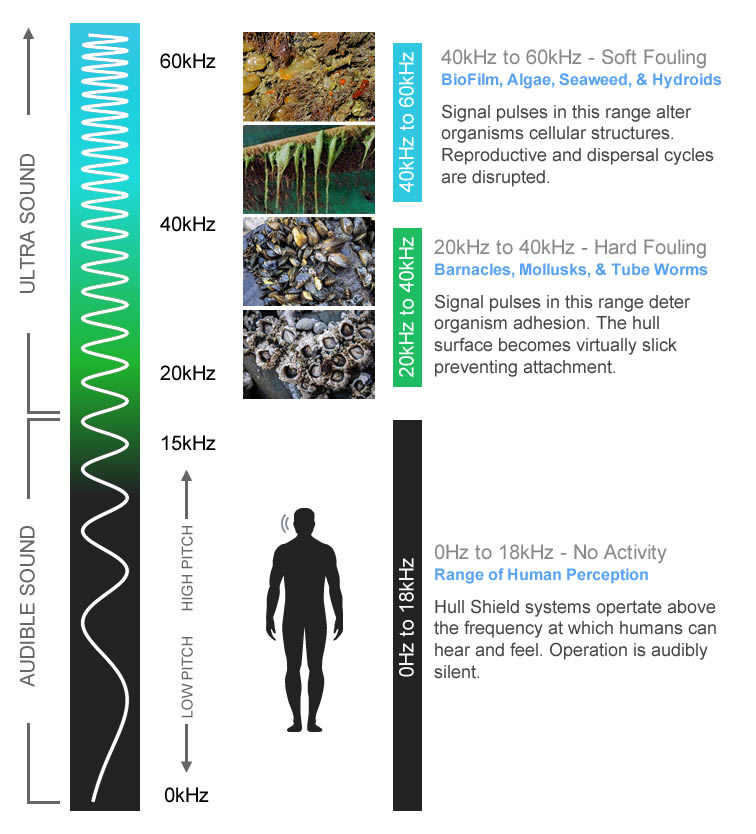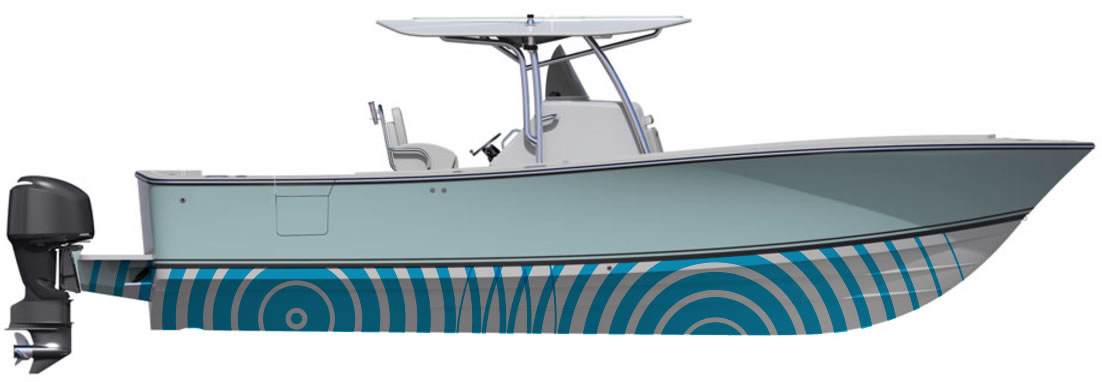Marine Fouling & Anti-Fouling Technologies
Fouling is the process of marine organisms attaching and growing on surfaces below the waterline. The most common method to fight back against fouling is the use of bottom paint.
Bottom paints and bottom coatings are available in a variety of formulations to help slow fouling. These bottom paints can include combinations of toxins, chemicals, and mechanical properties – the purpose is to prevent marine organisms from attaching to your underwater surfaces.
Bottom paint alone is not a very effective method of stopping marine fouling. Most all boats which are kept in the water must be routinely cleaned to remove the excessive fouling, with the bottom paint most effectively just providing an easily cleanable surface, protecting the hull from damage created by fouling and abrasive cleaners.
Ultrasonic antifouling provides much more prevention when compared to bottom paint alone. When ultrasonic antifouling is combined with bottom paint, a more effective solution is achieved, with the ultrasonic effect providing long periods between needed bottom cleaning, while the bottom paint provides physical protection of the hull and an easier, less damaging, cleaning experience.
Effects of Ultrasonic Stimulation
Ultrasounds are frequencies above that which can be heard or perceived by people. Ultrasound equipment is a large part of our daily lives and includes devices such vehicle parking sensors, ultrasound imaging in hospitals, and sonar on boats. Just as the frequency of light can produce a wide variety of phenomena such as radio, visible light, and microwaves, the same is true for sound – different frequencies will produce diverse effects ranging from imaging, communication signals, and mechanical vibration.
Different frequencies affect marine fouling in different ways. Ultrasounds between 20kHz and 40kHz produces a high pressure barrier along a surface. This microscopic barrier is only a few microns thick. Small organisms cannot occupy this high pressure space and are prevented from attaching, and repelled, from the surface.

Other frequencies have a different type of function. At frequencies above 40kHz, the cellular structure of fouling organisms that have attached to the surface begins to be effected. Common tasks related to organism life processes and reproduction cycles are disrupted within this frequency range.
Ultrasonic antifouling achieves a cleaner hull and running gear in two ways. First, by preventing new fouling from attaching to the protected surfaces. The second function is the disruption of fouling organisms ability to reproduce and spread across the protected surfaces. It’s important to remember that an ultrasonic anti-fouling system will not reverse existing fouling that was present on the hull prior to the system being installed – the effects of ultrasonic antifouling are preventative.

Implementation of Ultrasonic Antifouling
Unlike audible sound waves which can travel great distances through the air, ultrasound is most effectively transmitted through dense rigid surfaces. Consider ground penetrating radar – ultrasound can be utilized to create mapped images of depths over 100 feet through solid rock. Likewise, the ultrasound produced by Hull Shield systems spread through surfaces that are to be protected.
Hull Shield systems provide ultrasonic emitters which are bonded directly to the hull surface at evenly spaced intervals. These ultrasonic emitters transmit ultrasound into the hull and protected surfaces. The transmitters receive signals from a fully automatic control unit which is centrally located in the boat.

Frequently Asked Questions
Hull Shield works on all boats that do not have wood within the hull layers.
Yes. Hull Shield systems must operate continuously to maintain protection against marine growth.
No. Hull Shield functions as a deterrent and preventing new fouling from attaching or spreading on the hull surface. The hull must be cleaned prior to installation.
Less Frequently. Hull Shield systems function to extend the time between hull maintenance and cleaning.
Yes, Hull Shield systems are designed to integrate into your existing boat battery system.
No. Hull Shield transducers are isolated from all other parts of your boat while also operating with AC (alternating current) which will not functionally produce sustained electrolysis reaction.
No, the ultrasound produced by Hull Shield is perfectly safe for your boats structure and will not cause any damage or harm to your boat.
Hull Shield functions by producing ultrasound which cannot be sensed or heard by people. You may hear a slight clicking sound when very close to a transducer. A click is produced after a frequency transition and confirms the transducer is operational.
No. Hull Shield systems do not require any through-holes to install. Boats that contain composite or foam cores may require removal of the foam layer depending upon the installation method.
Yes. Hull Shield can be operated on battery systems sustained by solar power. The solar system must be able to sustain a continuous 1-2Ah draw, even during periods when the solar panels are not charging the batteries.
No. Hull Shield systems monitor the available battery voltage and adjust current draw based on available supply. The system will automatically switch to a “no-drain” sleep mode when battery levels dip below 50% capacity.
This depends on your circumstances. Hull Shield functions the same whether you have bottom paint or not – by extending the time required between cleaning. Hull Shield systems, when used in conjunction with a soft ablative bottom paint, will require less maintenance and cleaning than if no bottom paint is used. Boats using Hull Shield without bottom paint will still benefit with extended periods between cleaning compared to having no-protection, however removal of fouling will be more difficult. Having a bottom paint coating, even a non-toxic paint, will limit staining, fiberglass blistering, and aid in the easy removal of any accumulation.
Yes, Hull Shield functions as a deterrent of future growth – it will not retroactively remove existing barnacles or fouling. Please note that small barnacles can survive up to a month while out of the water. It is imperative that all barnacles are completely removed from submerged surfaces to ensure proper results.
Absolutely not. Hull Shield operates by producing ultrasound pulse that are then absorbed into the hull surfaces. Hull Shield will not interfere with marine fauna that is not in direct contact with the boat hull.
No. The hull surfaces must be able to conduct the generated ultrasound. When the hull is grounded, the ultrasound will be absorbed into the ground. More importantly, barnacles and other marine fauna are concentrated on the sea floor, thus creating an ideal environment for infestation.
